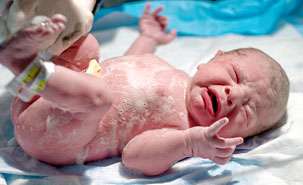Are we on the point of finding the key to a cure for HIV?

In newborns whose mothers are infected with HIV and who are not properly treated, combination antiretroviral therapy – or triple therapy – initiated within 72 hours after birth can help suppress the virus to the point where it becomes undetectable.
This is what is indicated by the results of a Canadian study co-authored by Hugo Soudeyns, researcher at the Centre de recherche du CHU Sainte-Justine and Chair of the Department of Microbiology, Infectiology & Immunology at Université de Montréal.
The study, which was recently published in the American journal Clinical Infectious Diseases, is the result of a collaboration between CHU Sainte-Justine, the University of Toronto's Hospital for Sick Children, and the University of Ottawa-affiliated Children's Hospital of Eastern Ontario.
Soudeyns and his Canadian colleagues, Fatima Kakkar, Ari Bitnun, Jason Brophy, Lindy Samson, and Stanley Read, examined birth records from the three hospitals for the last 15 years.
They identified 136 babies born to mothers infected with human immunodeficiency virus (HIV) who all received triple therapy within 72 hours of birth. Twelve of them were nonetheless infected with the HIV strain carried by their mothers. However, in four of them, the viral load was undetectable throughout the treatment.
Mississippi baby
The four cases are similar to the case known as the "Mississippi Baby."
In 2010, a baby girl was born at 35 weeks in a Mississippi clinic to a mother infected with HIV who had not been treated during her pregnancy. Thirty hours after her birth, the infant received combination antiretroviral treatment.
The viral load in the baby gradually disappeared: HIV was undetectable in her blood.
The girl was followed clinically until the age of 15 months, after which the family stopped medical monitoring. And even without the treatment, HIV remained undetectable when the doctors re-examined her at 23 months, and again at two and a half years of age.
In October 2012, Dr. Deborah Persaud of Johns Hopkins University in Baltimore published a study in the New England Journal of Medicine relating the case of the Mississippi Baby. The study concluded in a possible "functional cure" due to early treatment with combination antiretroviral therapy.
Promising research avenue
However, in June, Dr. Persaud announced that after 27 months without treatment, HIV had reappeared in the girl, who was now 4 years old. And the virus detected was identical to that of her mother.
"This suggests that the child's immune system was able to control the disease and that it forced the virus to hide," explains Soudeyns. "It raises questions that our Canadian study was interested in, namely, how did the immune response function during the 27 months the child was without treatment, and where did the virus hide?"
According to Soudeyns, an antibody may be present in the organism in minute quantities, but that is highly effective.
Recently, Soudeyns and his colleagues asked the Canadian Institutes of Health Research (CIHR) to contribute to a study to collect data from 250 children infected with HIV in 10 hospitals across the country. The goal is to better understand the immune mechanisms that force the virus to hide, and to identify the hiding places to track down HIV.
"The work done over the last two or three years gives hope to defeating HIV, not only to controlling it," says Soudeyns with some optimism. We believe we have found an avenue that may one day lead to a vaccine able to block HIV transmission, even among adults."



















